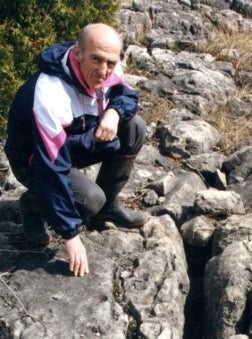Dr.
John
A.
Franklin,
an
important
figure
in
the
world
of
rock
engineering,
passed
away
on
6
July
2012.
John
Franklin
served
as
an
officer
in
the
Royal
Engineers
(1958-1963),
before
completing
his
BSc
in
Civil
Engineering,
an
MSc
in
Engineering
Geology,
and
a
PhD
in
Rock
Mechanics
at
the
Royal
School
of
Mines
(Imperial
College,
London).
During
his
stay
at
Imperial
College,
he
developed
testing
methods
that
form
the
basis
for
much
of
present-day
rock
classification.
John
Franklin
at
Science
North.
He
then
worked
as
a
consulting
rock
mechanics
engineer
in
the
USA,
Mexico,
and
the
UK,
before
moving
to
Canada
in
1975
and
founded
Franklin
Geotechnical
Ltd.
In
1982,
he
joined
the
University
of
Waterloo
as
a
part-time
research
professor
in
the
Department
of
Earth
Sciences,
where
he
taught
engineering
geology,
technical
writing,
tunneling
and
underground
works.
He
authored
and
co-authored
over
100
research
articles
and
wrote
two
college-level
textbooks.
Dr.
Franklin
served
as
the
President
of
the
International
Society
for
Rock
Mechanics
from
1987
to
1991.
He
also
worked
as
a
member
of
ISRM
Commissions
on
Rock
Mass
Classification
and
on
Swelling
Rock;
as
President
of
the
ISRM
Commission
on
Testing
Methods;
and
developed
programs
to
assist
the
newly
emerging
countries
of
Eastern
Europe.
As
an
executive
member
of
CARMA
(the
ISRM
in
Canada),
John
proposed
and
then
helped
organize
the
ISRM
Congress
in
Montreal
in
1987.
He
also
contributed
significantly
to
the
Canadian
Mine
Monitoring
Manual
and
a
similar
manual
on
Blast
Fragmentation
for
the
ISRM.
John
Franklin
on
Manitoulin
Island
(Right).
John
Franklin
was
involved
in
many
fascinating
projects
such
as
the
foundations
of
the
CN
Tower
in
Toronto,
the
Sudbury
Science
North
Centre
(seated
across
a
major
fault),
the
2100
meter
deep
Neutrino
Observatory
(SNOLAB)
in
Sudbury,
a
feasibility
study
for
a
tunnel
between
New
Brunswick
and
Prince
Edward
Island;
and
a
rock
breakwater
inTierra
del
Fuego
at
the
southern
tip
of
South
America.
He
was
well
known
internationally
for
his
contributions
to
design
engineering,
rock
testing
methods,
monitoring,
rock
fragmentation,
and
joint
fabric
analysis
through
imagery.
He
had
a
profound
understanding
of
the
intersection
between
geosciences
and
rock
engineering,
an
understanding
that
pervaded
his
professional
career.
John
was
diagnosed
with
Parkinson’s
disease
in
1991
but
continued
to
contribute
and
enrich
the
lives
of
everyone
around
him
with
his
irrepressible
elfish
humour.
He
died
in
2012
after
an
unusually
long
and
determined
fight
against
the
disease
that
eventually
defeated
his
physical
body
but
never
his
spirit.
His
wife
Dr.
Kerstine
Franklin
helped
John
greatly
during
his
last
years.
She
said
“despite
John’s
disease,
he
was
determined
to
live
life
to
the
fullest.
”In
his
last
years,
he
and
Kersty
were
co-proprietors
of
a
bed-and-breakfast
inn
in
Hockley
Valley,
Ontario.
The
single-minded
dedication
that
John
brought
to
rock
mechanics
and
rock
engineering
reminds
us
that
the
world
is
built
on
the
ideals
of
a
few
leading
visionaries.
John
was
such
a
visionary.
He
remained
intellectually
active
long
after
his
physical
disability
restricted
his
movements
and
travel
opportunities.
In
2011,
he
travelled
for
the
last
time
to
the
ISRM
quadrennial
Congress
in
Beijing.
He
was
saying
goodbye,
though
he
would
never
have
admitted
it.
If
the
International
Society
for
Rock
Mechanics
has
become
an
important
professional
organization,
it
is
partly
because
of
John
Franklin.
Maurice
Dusseault
and
Jim
Graham,
October.
2012

